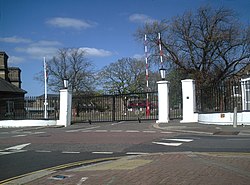Cavalry Barracks, Hounslow
| Cavalry Barracks, Hounslow | |
|---|---|
| Hounslow | |

Cavalry Barracks, Hounslow
|
|
|
Location within Greater London
|
|
| Coordinates | 51°28′10″N 00°23′21″W / 51.46944°N 0.38917°WCoordinates: 51°28′10″N 00°23′21″W / 51.46944°N 0.38917°W |
| Type | Barracks |
| Site information | |
| Owner | Ministry of Defence |
| Operator |
|
| Site history | |
| Built | 1793 |
| Built for | War Office |
| In use | 1793-Present |
| Garrison information | |
| Occupants | Irish Guards |
Cavalry Barracks is a British Army installation located north of Hounslow Heath in Hounslow, west London. Hounslow was one of 40 new barracks established around London to guard against possible French invasion in the late 18th and early 19th centuries.
The area around Hounslow Heath has been used for centuries to garrison Armies of The Crown because of its proximity to London, Windsor Castle and Hampton Court Palace. In the 17th century, Oliver Cromwell marshalled an army on the heath at the end of the English Civil War in 1647. James II also camped his troops here to hold military exercises in an unsuccessful attempt to intimidate the Parliament in London shortly before the Glorious Revolution.
In 1793, the area became a permanent barracks for troops using the heath when permanent buildings were erected as part of the British response to the threat of the French Revolution. The barracks became a busy depot for the London military district. Florence Nightingale undertook some of her early training at Hounslow.
In June 1846, Private Frederick John White was flogged after a Court-martial sentenced him to 150 lashes for insubordination at Hounslow Barracks. He died a month later making him the last soldier to die after a flogging in the British Army. White was buried in nearby St Leonard's churchyard, Heston. Calls for abolishment of flogging were made in Parliament; it was eventually outlawed in 1881.
...
Wikipedia

